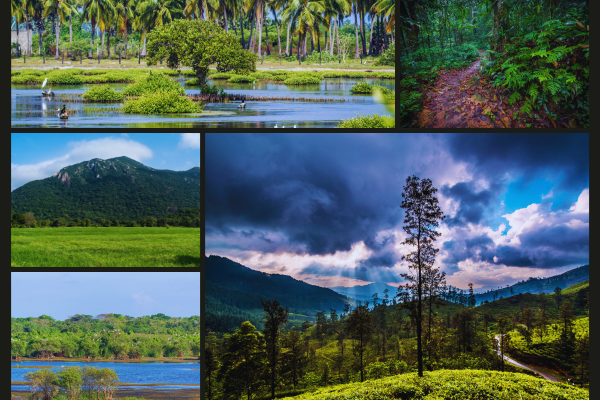Hidden Gems for Eco-Tourism in Sri Lanka: Discovering Nature’s Serenity – By Malsha – eLanka

Sri Lanka, often called the “Pearl of the Indian Ocean,” is not only renowned for its rich history and cultural heritage but also for its lush landscapes and diverse ecosystems. While popular tourist destinations like Yala National Park and Sigiriya rock fortress attract thousands of visitors annually, there are lesser-known eco-tourism spots that offer equally stunning beauty and tranquillity. Here are some of Sri Lanka’s hidden gems for eco-tourism, perfect for those looking to connect with nature, wildlife, and sustainable travel experiences.
1. Sinharaja Forest Reserve
A UNESCO World Heritage Site, Sinharaja Rainforest is one of the last remaining primary rainforests in Sri Lanka. The biodiversity here is staggering, with a high rate of endemic species including birds, mammals, reptiles, and insects. Guided walks through this dense forest allow visitors to witness rare species like the purple-faced langur and the Sri Lankan blue magpie. The towering trees, cascading waterfalls, and lush greenery make Sinharaja a must-visit for eco-tourists and nature lovers alike.
Why it’s a hidden gem: Despite its global significance, Sinharaja remains relatively uncrowded compared to other parks. Its remote location means fewer tourists, ensuring an immersive, peaceful experience.
2. Knuckles Mountain Range
Nestled in central Sri Lanka, the Knuckles Mountain Range is a rugged and remote wilderness that offers some of the island’s best trekking opportunities. With its mist-covered peaks, cloud forests, and cascading waterfalls, Knuckles is a biodiversity hotspot. It’s home to many endemic species of plants and animals, and visitors can explore its beauty through numerous hiking trails. The range also provides an opportunity to interact with local communities and learn about their sustainable agricultural practices.
Why it’s a hidden gem: Knuckles is lesser-known compared to the more popular Horton Plains, making it a haven for eco-tourists looking to escape the crowds and explore unspoiled nature.
3. Kalpitiya Lagoon and Dolphin Watching
Kalpitiya, located on the northwestern coast of Sri Lanka, is an off-the-beaten-path destination famous for its marine biodiversity. The region’s lagoon system is an ideal spot for eco-friendly water sports like kitesurfing, kayaking, and snorkeling. Kalpitiya is also one of the best places in Sri Lanka for dolphin watching, with pods of spinner dolphins frequently seen dancing in the waters. The nearby Bar Reef, Sri Lanka’s largest coral reef, offers exceptional snorkeling and diving opportunities.
Why it’s a hidden gem: While Mirissa is a popular spot for whale and dolphin watching, Kalpitiya’s dolphin population is just as spectacular but sees fewer tourists, preserving its tranquil atmosphere.
4. Kanneliya Forest Reserve
Located near the southern city of Galle, the Kanneliya Forest Reserve is part of the island’s lesser-known rainforests. This biosphere reserve is a sanctuary for rare flora and fauna, with over 301 plant species and an abundance of birdlife. The forest is crisscrossed by freshwater streams and rivers, making it an excellent location for nature walks and birdwatching. The less commercialized atmosphere compared to other reserves makes Kanneliya a perfect escape for eco-tourists seeking serenity.
Why it’s a hidden gem: Kanneliya is often overshadowed by the more famous Sinharaja Rainforest, but its biodiversity is equally impressive, and it offers a quieter, more intimate experience.
5. Wasgamuwa National Park
For wildlife enthusiasts, Wasgamuwa National Park is a true hidden gem. Located in the central province, this park is less frequented than its counterparts like Yala or Udawalawe, making it an ideal location for peaceful wildlife safaris. Wasgamuwa is known for its large herds of elephants, as well as leopards, sloth bears, and over 140 species of birds. The park’s mixed evergreen forests and grasslands make it a picturesque destination for eco-tourism.
Why it’s a hidden gem: Wasgamuwa offers a more laid-back safari experience without the crowds, allowing visitors to connect deeply with nature and wildlife.
6. Gal Oya National Park and Boat Safaris
Gal Oya National Park, located in the eastern part of Sri Lanka, is one of the least visited parks on the island, yet it offers a unique experience—boat safaris. Visitors can explore Sri Lanka’s largest reservoir, Senanayake Samudraya, and witness elephants swimming from one island to another in search of food. The park is also a haven for birdwatchers, with over 150 species recorded.
Why it’s a hidden gem: The combination of boat safaris and the park’s remote location makes Gal Oya a distinctive and offbeat choice for eco-tourists.
7. Wilpattu National Park
Wilpattu, one of Sri Lanka’s oldest and largest national parks, is a treasure trove of wildlife and natural beauty. The park is famous for its leopard population and “villus” (natural lakes) that dot the landscape. Unlike other parks, Wilpattu’s vastness and limited number of visitors make it an ideal destination for those who seek solitude and intimate wildlife encounters.
Why it’s a hidden gem: Although Wilpattu is slowly gaining recognition, it remains less crowded compared to Yala, providing a quieter, more immersive safari experience.
8. Mannar Island
Mannar Island, located in the far north-west, offers a unique eco-tourism experience. The island’s stark, arid landscape contrasts with the lush greenery found elsewhere on the island, and it is a critical stopover for migratory birds, making it a birdwatcher’s paradise. The shallow waters around Mannar are also home to a thriving population of dugongs, a rare and endangered marine mammal.
Why it’s a hidden gem: Mannar Island is off the typical tourist trail, offering unspoiled natural beauty and rare wildlife experiences for eco-conscious travelers.
9. Rekawa Turtle Sanctuary
For travelers passionate about marine conservation, the Rekawa Turtle Sanctuary on Sri Lanka’s southern coast offers the opportunity to witness sea turtles laying their eggs. This community-based conservation project works to protect endangered sea turtles from poaching and habitat destruction. Visitors can participate in night-time beach patrols to observe turtles in their natural habitat and learn about conservation efforts.
Why it’s a hidden gem: Unlike more commercial turtle hatcheries, Rekawa offers an authentic, eco-friendly experience focused on conservation rather than tourism.























